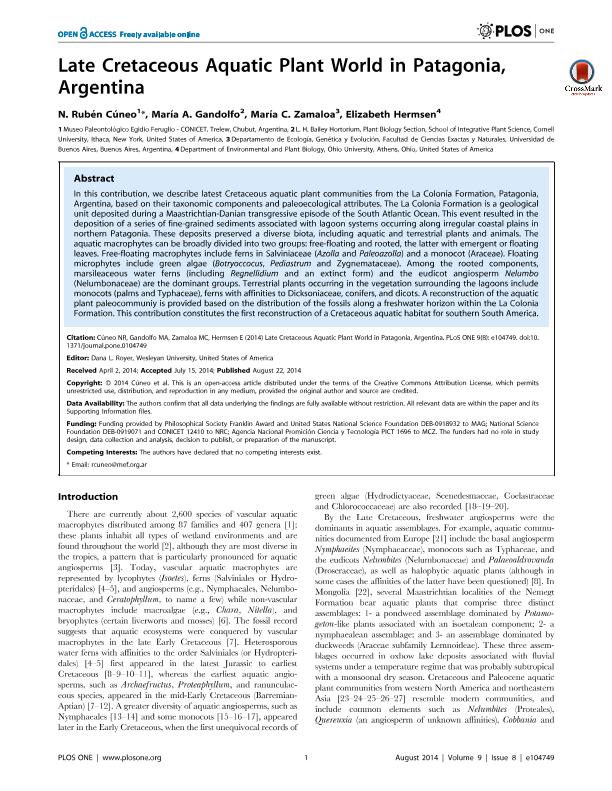Mostrar el registro sencillo del ítem
dc.contributor.author
Cúneo, Néstor Rubén

dc.contributor.author
Gandolfo, María A.
dc.contributor.author
Zamaloa, María del Carmen

dc.contributor.author
Hermsen, Elizabeth
dc.date.available
2017-07-19T20:29:50Z
dc.date.issued
2014-08
dc.identifier.citation
Cúneo, Néstor Rubén; Gandolfo, María A.; Zamaloa, María del Carmen; Hermsen, Elizabeth; Late Cretaceous aquatic plant world in Patagonia, Argentina; Public Library of Science; Plos One; 9; 8; 8-2014; 1-18; e104749
dc.identifier.issn
1932-6203
dc.identifier.uri
http://hdl.handle.net/11336/20957
dc.description.abstract
In this contribution, we describe latest Cretaceous aquatic plant communities from the La Colonia Formation, Patagonia, Argentina, based on their taxonomic components and paleoecological attributes. The La Colonia Formation is a geological unit deposited during a Maastrichtian-Danian transgressive episode of the South Atlantic Ocean. This event resulted in the deposition of a series of fine-grained sediments associated with lagoon systems occurring along irregular coastal plains in northern Patagonia. These deposits preserved a diverse biota, including aquatic and terrestrial plants and animals. The aquatic macrophytes can be broadly divided into two groups: free-floating and rooted, the latter with emergent or floating leaves. Free-floating macrophytes include ferns in Salviniaceae (Azolla and Paleoazolla) and a monocot (Araceae). Floating microphytes include green algae (Botryoccocus, Pediastrum and Zygnemataceae). Among the rooted components, marsileaceous water ferns (including Regnellidium and an extinct form) and the eudicot angiosperm Nelumbo (Nelumbonaceae) are the dominant groups. Terrestrial plants occurring in the vegetation surrounding the lagoons include monocots (palms and Typhaceae), ferns with affinities to Dicksoniaceae, conifers, and dicots. A reconstruction of the aquatic plant paleocommuniy is provided based on the distribution of the fossils along a freshwater horizon within the La Colonia Formation. This contribution constitutes the first reconstruction of a Cretaceous aquatic habitat for southern South America.
dc.format
application/pdf
dc.language.iso
eng
dc.publisher
Public Library of Science

dc.rights
info:eu-repo/semantics/openAccess
dc.rights.uri
https://creativecommons.org/licenses/by/2.5/ar/
dc.subject
Paleoenvironments
dc.subject
Paleoecology
dc.subject
Cretaceous
dc.subject
South America
dc.subject.classification
Paleontología

dc.subject.classification
Ciencias de la Tierra y relacionadas con el Medio Ambiente

dc.subject.classification
CIENCIAS NATURALES Y EXACTAS

dc.subject.classification
Ecología

dc.subject.classification
Ciencias Biológicas

dc.subject.classification
CIENCIAS NATURALES Y EXACTAS

dc.title
Late Cretaceous aquatic plant world in Patagonia, Argentina
dc.type
info:eu-repo/semantics/article
dc.type
info:ar-repo/semantics/artículo
dc.type
info:eu-repo/semantics/publishedVersion
dc.date.updated
2017-06-30T13:28:24Z
dc.journal.volume
9
dc.journal.number
8
dc.journal.pagination
1-18; e104749
dc.journal.pais
Estados Unidos

dc.journal.ciudad
San Francisco
dc.description.fil
Fil: Cúneo, Néstor Rubén. Museo Paleontológico Egidio Feruglio; Argentina. Consejo Nacional de Investigaciones Científicas y Técnicas; Argentina
dc.description.fil
Fil: Gandolfo, María A.. Cornell University; Estados Unidos
dc.description.fil
Fil: Zamaloa, María del Carmen. Universidad de Buenos Aires. Facultad de Ciencias Exactas y Naturales. Departamento de Ecología, Genética y Evolución; Argentina
dc.description.fil
Fil: Hermsen, Elizabeth. Ohio University; Estados Unidos
dc.journal.title
Plos One

dc.relation.alternativeid
info:eu-repo/semantics/altIdentifier/doi/http://dx.doi.org/10.1371/journal.pone.0104749
dc.relation.alternativeid
info:eu-repo/semantics/altIdentifier/url/http://journals.plos.org/plosone/article?id=10.1371/journal.pone.0104749
Archivos asociados
